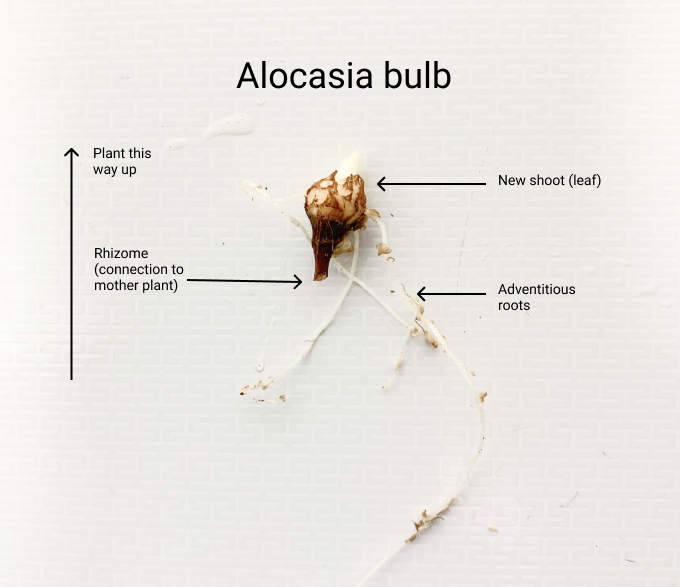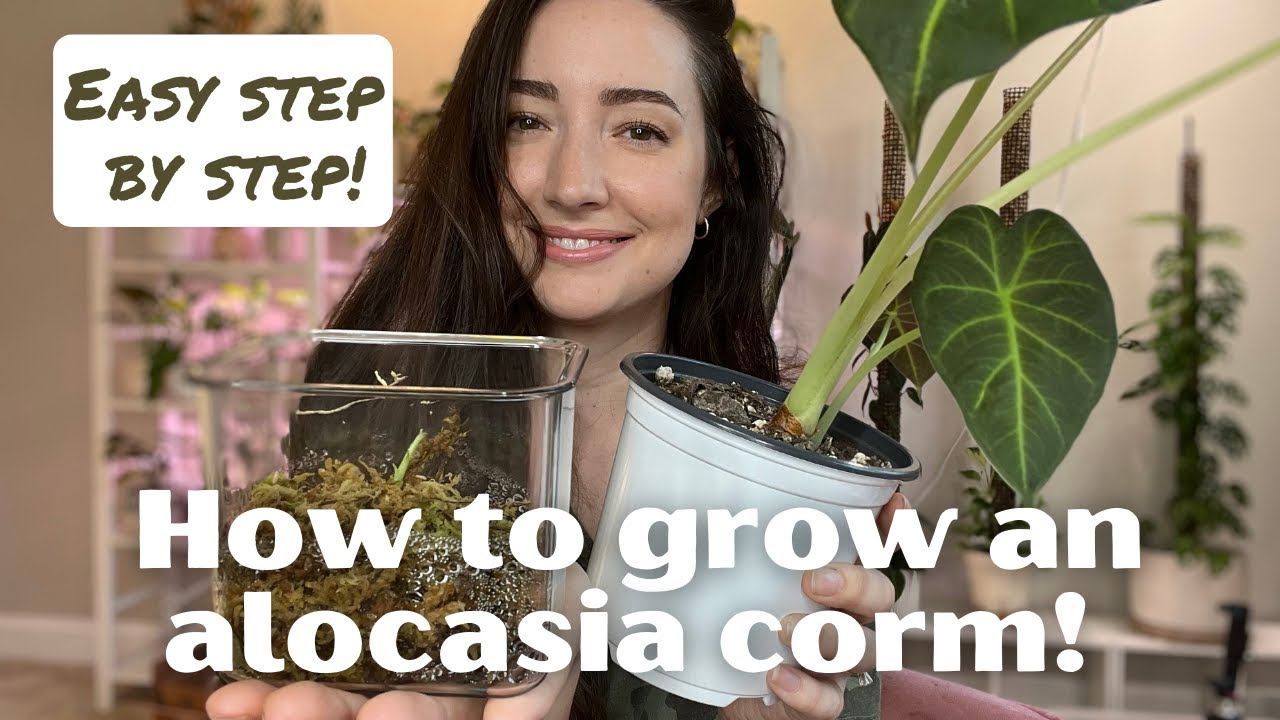To plant Alocasia corms, dig a hole at least twice as deep as the corm and space them about 2-3 feet apart. Alocasia corms should be planted in well-draining soil with partial shade and watered regularly to keep the soil moist but not soggy.
With their stunning foliage and unique appearance, Alocasia plants have become popular choices among gardeners and plant enthusiasts. These tropical plants are native to Southeast Asia and are known for their large, impressive leaves. One of the most important steps to ensure the successful growth of Alocasia is to properly plant the corms.
We will explore the step-by-step process of planting Alocasia corms, including the ideal soil conditions and watering requirements. By following these guidelines, you can create a thriving and beautiful Alocasia garden in your own backyard.

Credit: botanicalbrunette.com
Choosing The Right Alocasia Corms
Selecting the right Alocasia corms is crucial for successful planting. When choosing, opt for firm, plump corms free from any signs of decay or rot. Look for healthy, compact growth points, which indicate vigorous sprouting. Prioritize corms that exhibit overall vitality and promise robust growth once planted.
Selecting Healthy Corms
When it comes to planting Alocasia corms, selecting healthy ones is crucial for a successful growth journey. By choosing corms that are vibrant, firm, and free from any signs of damage or disease, you increase the chances of a thriving plant.
Understanding Alocasia Varieties
Before diving into the process of choosing the right Alocasia corms, it’s important to understand the different varieties available. Alocasia plants come in an array of shapes, sizes, and colors, each with their own unique characteristics. Some popular varieties include:
– Alocasia reginula: Also known as the Black Velvet, this variety boasts stunning dark leaves with contrasting silver veins.
– Alocasia amazonica: Recognized by its deep green foliage and prominent white veins, this variety is a favorite among plant enthusiasts.
– Alocasia macrorrhiza: Commonly referred to as Giant Taro or Elephant Ear, this variety features oversized, heart-shaped leaves that can reach impressive sizes.
Knowing the distinct traits of these varieties will help you make an informed decision when selecting your Alocasia corms.
Table: Alocasia Varieties
| Variety | Features |
|---|---|
| Alocasia reginula | Dark leaves with silver veins |
| Alocasia amazonica | Deep green foliage with white veins |
| Alocasia macrorrhiza | Oversized, heart-shaped leaves |
Now that you have a better understanding of Alocasia varieties, it’s time to move on to selecting the right corms. Remember, healthy corms are the foundation for a thriving Alocasia plant.
How to Plant Alocasia Corms : Step by Step Guide
Preparing The Planting Site
To prepare the planting site for Alocasia corms, start by choosing a location with well-draining soil and partial shade. Dig a hole that is double the size of the corm and place the corm with the pointy side facing up.
Cover it with soil and water it thoroughly.
Choosing The Right Location
Before planting your Alocasia corms, it’s crucial to choose the right location in your garden. Alocasias thrive in areas with partial shade, where they can receive filtered sunlight for a few hours each day. Look for a spot that offers protection from direct sunlight and strong winds. This will prevent the delicate leaves from scorching or getting damaged. Alocasias also prefer areas with good air circulation, so keep this in mind when selecting your planting site.
Soil Preparation
Preparing the soil is key to ensuring successful growth and development of your Alocasia plants. Start by checking the soil drainage. Alocasias dislike soggy conditions, so it’s essential to ensure good water drainage. If the soil in your chosen area retains water for prolonged periods, you may need to improve the drainage by adding organic matter like compost or peat moss to the soil. This helps loosen compacted soil and allows root penetration.
Next, test the soil pH. Alocasias prefer slightly acidic to neutral soil with a pH range of 5.5 to 7. If your soil is too acidic or alkaline, you can amend it by adding lime or sulfur accordingly. Use a soil testing kit to determine the existing pH level and make the necessary adjustments. A slightly acidic soil pH enhances nutrient availability for the plants, promoting healthy growth.
After addressing drainage and pH levels, focus on soil fertility. Alocasias require rich, fertile soil to thrive. Incorporate well-aged compost or well-balanced organic fertilizer into the planting site. This not only provides essential nutrients but also improves soil structure and moisture retention. Ensure the soil preparation is done thoroughly, as it sets the foundation for your Alocasias’ growth and overall health.
Planting Alocasia Corms
Planting Alocasia corms is an exciting process that can bring a touch of tropical beauty to any garden. To ensure the success of your venture, it’s important to follow the proper planting techniques. In this section, we will discuss everything you need to know about planting Alocasia corms, including digging the holes, planting depth, and spacing.
Digging The Holes
Before you start planting your Alocasia corms, it’s important to have the right holes prepared. Alocasia plants prefer well-draining soil, so begin by digging holes that are approximately twice the size of the corm itself. This will allow for proper root growth and prevent any excess moisture from accumulating. Spread the holes out to provide enough spacing for each corm.
Planting Depth And Spacing
The next step in planting Alocasia corms is to consider the planting depth and spacing. Place each corm in the prepared hole with the pointed end facing upwards. The ideal planting depth is around 4-6 inches below the surface for most Alocasia varieties. Make sure to space the corms at least 18-24 inches apart to allow room for their growth and development.
If you are planting multiple corms, you can create a visually appealing arrangement by planting them in clusters or rows. This will not only enhance the aesthetic appeal but also allow the plants to grow and thrive without excessive competition for resources.
Pro tip: Alocasia plants love warmth and humidity, so consider placing the corms in a location that receives partial shade and offers protection from harsh afternoon sun. This will help keep them happy and healthy.
Now that you know the proper techniques for planting Alocasia corms, you can confidently begin your own tropical garden. Remember to provide adequate water and proper care to ensure your Alocasia plants thrive and bring a burst of beauty to your outdoor space.

Credit: blog.symmetrees.com
Caring For Alocasia Corms
Once you have successfully planted your Alocasia corms, it’s important to provide them with the care they need to thrive. Here are two key aspects of caring for Alocasia corms: Watering and Humidity, and Fertilizing and Mulching.
Watering And Humidity
To ensure the health of your Alocasia corms, proper watering and humidity levels are crucial. These tropical plants thrive in moist environments, so it’s important to keep the soil consistently moist, but not waterlogged. Overwatering can lead to rot, while underwatering can cause the corms to dry out.
To maintain optimal moisture levels, follow these tips:
- Water your Alocasia corms when the top inch of soil feels dry to the touch.
- Use room temperature water, as cold water can shock the roots.
- Avoid allowing water to sit in the saucer beneath the pot, as this can lead to root rot.
- Mist the leaves regularly to provide the necessary humidity, especially in dry indoor environments.
Fertilizing And Mulching
Fertilizing your Alocasia corms helps provide the nutrients they need to grow strong and vibrant. A well-balanced, slow-release fertilizer is ideal for these plants. Apply the fertilizer according to the instructions on the package, typically every 4-6 weeks during the growing season.
In addition to fertilizing, mulching can also benefit your Alocasia corms by preserving moisture and protecting the roots. Organic mulches, such as wood chips or compost, work well for these plants. Apply a layer of mulch around the base of the plant, making sure to keep it a few inches away from the stem to prevent rot.
By providing the right care through proper watering, humidity, fertilizing, and mulching, your Alocasia corms will flourish and reward you with their stunning foliage.
Managing Pests And Diseases
Growing Alocasia corms can be a rewarding experience for any gardener. However, just like any other plant, these exotic beauties are susceptible to pests and diseases. Proper management of pests and diseases is crucial in ensuring the healthy growth of your Alocasia plants, so let’s look at how you can tackle these issues.
Identifying Common Pests
Alocasia plants are prone to attacks by common pests such as mealybugs, spider mites, and aphids. These pests can cause wilting, yellowing of leaves, and stunted growth in your Alocasia plants. Regular inspection of the leaves and stems is essential in identifying and controlling these pests. Look out for tiny webs or powdery residues on the leaves, which may indicate the presence of spider mites or mealybugs, respectively.
Dealing With Diseases
Alocasia plants are susceptible to fungal diseases such as leaf spot and root rot. To prevent these diseases, ensure proper ventilation and avoid overwatering. If you notice brown spots or moldy patches on the leaves, it may indicate a fungal infection. Prune the affected parts and ensure proper airflow around the plant to prevent further spread of the disease.

Credit: www.youtube.com
Frequently Asked Questions On How To Plant Alocasia Corms
Which Way Up Do You Plant Alocasia Corms?
Plant Alocasia corms with the pointed end facing up.
Can I Plant Alocasia Corms In Soil?
Yes, you can plant Alocasia corms in soil. Just make sure to choose a well-draining soil mix and plant the corms 2-3 inches deep. Place them in a bright, indirect light spot and water them regularly. Remember to allow the soil to dry slightly between watering.
Can You Root Alocasia Corms In Water?
Yes, you can root Alocasia corms in water.
How Do I Plant A Corm?
To plant a corm, choose a location with well-draining soil. Dig a hole twice the corm’s size and place it in, flat side down. Cover with soil and water thoroughly. Ensure it receives sunlight. Water when soil dries out, and your corm will grow.
Conclusion
Planting Alocasia corms is a straightforward process that can be enjoyed by both experienced and amateur gardeners. By following these steps, you can ensure the successful growth and beautiful display of these stunning plants in your garden. Remember to choose a suitable location, prepare the soil, and provide adequate care to promote healthy growth.
With proper attention and nurturing, your Alocasia plants are sure to thrive and add an exotic touch to your outdoor space. Happy gardening!

